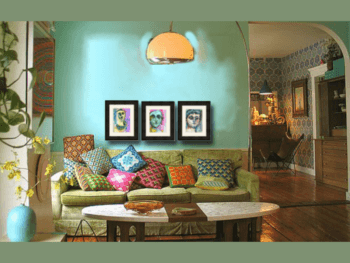
Putting your house up for sale? Not yet, you’re not. Take a look at our guide to the mysterious and intricate art of home staging and learn how doing things that can save you a world of aggravation, not to mention a wad of cash.
Selling your house is one of the most stressful things you’ll ever do—the emotional strain, the near 24/7 cleaning and of course, the mounting stress as weeks turn to months and your property just isn’t moving. What’s the problem? Are the kitchen floors too dated? Is the bedroom too small? Are your kids warding off prospective buyers with tales of a tormented spirit roaming the basement? Most likely, it’s a combination of things, because what many people fail to realize is that there’s much more to selling a house than sticking a sign on your lawn and incessant vacuuming.
Founder of Canadian home-staging service Staged2Sell and author of Home Staging for Dummies, Christine Rae is at the forefront of a burgeoning field of real-estate professionals who are part decorator and part market analyst. While staging is a highly case-sensitive process, one thing’s universal: these days, if you want to sell, you’ve gotta market.
“You can no longer say ‘tough, this is the way I live—take me or not,’” Rae explains. Instead, with such a crowded and costly market, you need to be “appealing to the targeted buyer’s aspiration of lifestyle.”
“Ten years ago,” she recalls, “if you went into someone’s kitchen and opened up their kitchen cupboard and saw everything in perfect order, you’d say, ‘This woman needs to get herself a life.’ Today, a buyer opens up a cupboard like that and goes ‘Oh my God, I want this life; I want the time to have my cupboards organized.’”
In short, you’re selling possibility; that means turning your comfy, lived-in home back into a spotless new house that will have the buyer fantasizing about how she can turn into her own ideal home. The first impediment to that transformation is your stuff. Family photos, toiletries, toys and political or religious icons need to be boxed up, as do most of the items in your closets, cupboards and even the garage.
“People are going to [look for] closet space,” Rae explains, “and if it’s overrun with all your winter clothes, it looks like there’s no room for them to move in. So pack away two-thirds of all the cupboards, closets and buy wooden hangers to colour code what’s left in the closets. Put things into baskets on shelves and clear the floor underneath.”
However, that’s just the beginning. In addition to comprehensive cleaning, things like stains, peeling wallpaper, drab paint jobs and anything else that takes away from that “new home” feeling needs to be fixed. You may think they’re too small to be of any bother, but potential buyers will fixate on them, more so than even they realize.
“Remember that people buy emotionally and then support their emotional decisions intellectually,” Rae cautions. “So if I go in and I see somebody’s property that has dust or curling ends or chips on the paint, [it] suggests a feeling of neglect. It’s [actually just] lived-in, but the perception is it’s neglect. And when I can visibly see these things, I then start to question subliminally—do you have cracks in your basement that you haven’t taken care of? Do you have leaks in your roof that I can’t see right now? If you ever find yourself thinking ‘they won’t notice,’ think again, because they will.”
In some cases, full-on renovation may even be required. If you’ve got an older home, you need to evaluate whether it’s up-to-date enough to satisfy buyer expectations for your area. Are your laminate floors stuck in the ’70s? Do your ratty old kitchen countertops or cabinets need to be replaced? It may seem like a substantial investment for a house you’re about to leave, but as Rae is quick to caution, given the recent upswing in mortgage rates, people are less willing than ever to buy a “fixer-upper.”
And you risk losing a lot more if you don’t invest in quality. “Most properties will drop $20,000 after three weeks,” she explains. “In the first couple of weeks that the house is on the market, that’s when the most people ever will go through your property. And if you’ve wasted that time, then you have to redouble your efforts to get those people re-interested.” Ultimately, you should spend up to three per cent of your asking price for renovations, decorative accessories like vases and fresh flowers, etc., and, yes, professional consulting fees.
As much as you might like to save a few bucks by going it alone, the guidance of a trained stager cannot be underestimated, especially when it comes to the décor and things like furniture placement and colour coordinating.
Of those two, the former is the easiest for an amateur to deal with, and once again it’s all about opening up space. To that end, using smaller furniture will ensure that small rooms appear larger. “A lot of South Asian families tend to have large furniture in their principal rooms,” explains Pooja Kaushal, a stager with extensive experience in the South Asian market. “This can give the illusion of the room being smaller. To make a space look bigger, you might want to consider editing [your] furniture; for example, it might be a good idea to reconfigure a smaller living room with a couch, a loveseat and armchair to a couch and armchair.”
Moreover, consider swapping pieces between rooms or even buying new pieces if what you have isn’t working. Above all, don’t bunch up your chairs and tables; spacious sitting areas mean a more spacious-looking room.
Beyond that, things get a bit more case-sensitive and complex. Kaushal demonstrates the advantage of having a pro in your corner. “If the smallest room in the house has walls that are a bright orange,” explains Kaushal, “that would overpower the space. Consider repainting three walls a lighter color and keep the orange as an accent wall. It will give the room some personality and yet make it look bigger and brighter, in a good way.”
One final thing to consider is smell. Simply put, don’t have one. “The best scent is no scent,” she advises. Whether it’s Febreze or baked bread, artificial scents only cover up odour and again give that subliminal sense that you’re hiding something. Fresh air is what you want.” What’s more, watch what you eat. “I think the advice I would give South Asian sellers in general,” says Kaushal, “would be to air the house of any smells. We love the food but strong smells of food are not appealing.”
Now, as for where to focus your efforts, in addition to organizing space, the most important areas, both women agree, are the kitchen and the bathrooms; if you nail those spaces, other drawbacks can be more easily forgiven. The kitchen should be as up-to-date as possible, ideally with features such as granite countertops, modern appliances, light colours, new (or at least freshly painted) cabinets with nice hardware and no exposed food. As for the bathroom, cleanliness is king—meaning no mould, cracked tiles or exposed plungers—as is having plenty of light and bright colours. All that being said, you really can’t afford to neglect any room in the house.
“When somebody falls in love at first glance, from the minute they step inside, that impression is being formed,” explains Rae. “And if they have to wait to get to the family room to be impressed, then that family room has to work way harder to change the mindset of the person that’s already kind of starting to scratch you out. Most people only take about three minutes to walk through a property. There’s very little opportunity to get a sale if you haven’t done it well from the beginning.”
And “beginning” actually starts before they even set foot in your house. “Today, 93 per cent of people who buy a house look on the Internet first, which means that you have to have really stellar photographs to capture their interest. Seventy-four per cent of those people will drive by the property before they ever contact anybody to go take a look at it. Half of those people will go by at night; so if you’re not well-lit, if the number is difficult to see, you’re risking getting scratched off.” Translation: mow that lawn, wash those windows and invest in some spotlights.
In the end, remember: buyers are looking for reasons to ignore you; don’t give them any. Be thorough, be flawless and offer them a space that’ll have their imagination running wild with possibilities. Before you know it, you’ll be slapping a “Sold” sticker over that “For Sale” sign, much to the chagrin of a busload of outbid suitors.
BY MATTHEW CURRIE / PUBLISHED: THE PASSION ISSUE, MAY 2011




















































































































